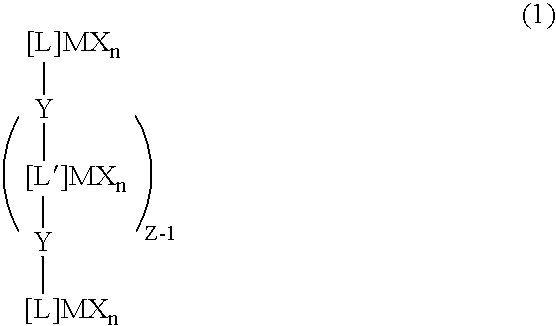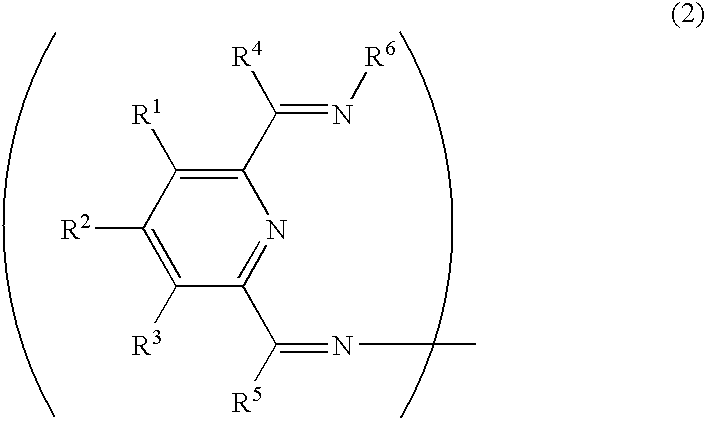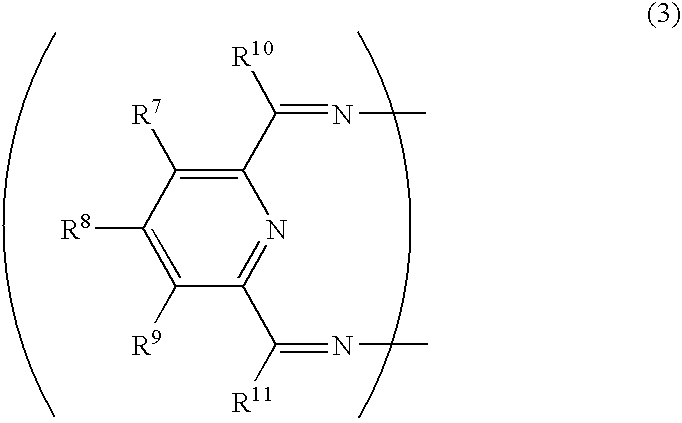Transition metal compound, olefin polymerization catalyst, and method of polymerizing olefin
a technology of olefin polymerization and transition metal, which is applied in the direction of catalyst activation/preparation, chemical/physical processes, iron organic compounds, etc., can solve the problems of high cost of aluminoxane, low activity of nickel complex used therein, and large quantity of side products, polymers and waxes
- Summary
- Abstract
- Description
- Claims
- Application Information
AI Technical Summary
Benefits of technology
Problems solved by technology
Method used
Image
Examples
example 1
Preparation of Compound 3
(1) Ligand Preparation:
100 ml of methanol, 1.63 g of 2,6-diacetylpyridine (molecular weight 163.18; 10 mmols), 4.84 g of 2,4-dimethylaniline (molecular weight 121.18; 40 mmols) and 680 mg of 2,5-dimethyl-1,4-phenylenediamine (molecular weight 136.20; 5 mmols) were put into a 300 ml flask, and thoroughly stirred to prepare a homogenious mixture. 0.6 ml of formic acid was added to this, and further the mixture was stirred for 12 hours to make the compounds reacted completely. The resulting pale yellow crystal was taken out through filtration, washed with methanol, and dried under reduced pressure. Its 1H-NMR spectrum was assigned as the following product (molecular weight 632.85; 1.46 g, 2.3 mmols, yield 46%).
1H-NMR [90 MHz, solvent: CDCl3, based on tetramethylsilane (δ 0.00)]):
(2) Complex Preparation:
Next, a tetrahydrofuran solution (20 ml) of the ligand prepared herein (molecular weight 632.85; 633 mg, 1.0 mmol) and a tetrahydrofuran solution (20 ml) of fer...
example 2
250 ml of toluene and 0.5 ml of a toluene solution of polymethylaluminoxane (from Toso-Akzo, having a concentration of 1 mmol / ml) were put into a 1 liter autoclave, and 0.25 ml of a toluene suspension of Compound 3 (concentration: 1 μmol / ml) prepared in Example 1 was added thereto. 10 g of an internal standard, n-undecane was added thereto, and heated up to 50° C. After this was heated, ethylene was continuously introduced thereinto with its pressure being kept at 1.0 MPa, and reacted at 50° C. for 30 minutes. Next, an aqueous solution of sodium hydroxide (1 mol / liter) was added to the system to stop the reaction.
After the reaction, the autoclave was degassed, and the total volume of the gaseous component was measured with a wet flow meter. The gaseous component was analyzed to quantify the constituent components through gas chromatography. The α-olefin in the solution was quantitatively analyzed through gas chromatography using n-undecane as the internal stan...
example 3
Preparation of Compound 27
Compound 27
(1) Ligand Preparation:
100 ml of methanol, 19.6 g of 2,6-diacetylpyridine (molecular weight 163.18; 120 mmols) and 55.9 g of aniline (molecular weight 93.13; 600 mmols) were put into a 300 ml flask, and thoroughly stirred to prepare a homogeneous mixture. 0.6 ml of formic acid was added to this, and further the mixture was stirred at room temperature for 12 hours to make the compounds reacted completely. The resulting yellow crystal was taken out through filtration, washed with methanol, and dried under reduced pressure to obtain 34.5 g of 2,6-diacetylpyridine-diphenylimine (molecular weight 313.40; 110 mmols, yield 91%).
100 ml of tetrahydrofuran, 6.3 g (20 mmols) of 2,6-diacetylpyridine-diphenylimine and 0.82 g of 2,3,5,6-tetramethyl-1,4-phenylenediamine (molecular weight 164.25; 5 mmols) were put into a 300 ml flask, and thoroughly stirred to prepare a homogeneous mixture. 0.6 ml of formic acid was added to this, and further stirred at room tem...
PUM
| Property | Measurement | Unit |
|---|---|---|
| aromatic | aaaaa | aaaaa |
| degree of polymerization | aaaaa | aaaaa |
| ferromagnetic | aaaaa | aaaaa |
Abstract
Description
Claims
Application Information
 Login to View More
Login to View More - R&D
- Intellectual Property
- Life Sciences
- Materials
- Tech Scout
- Unparalleled Data Quality
- Higher Quality Content
- 60% Fewer Hallucinations
Browse by: Latest US Patents, China's latest patents, Technical Efficacy Thesaurus, Application Domain, Technology Topic, Popular Technical Reports.
© 2025 PatSnap. All rights reserved.Legal|Privacy policy|Modern Slavery Act Transparency Statement|Sitemap|About US| Contact US: help@patsnap.com



